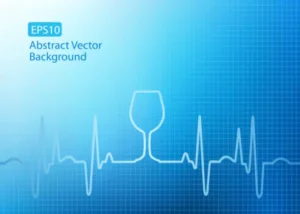Alcoholic cardiomyopathy: Treatments, outlook, and more

It is therefore possible that most of these studies may have also consistently omitted most alcohol abusers in whom alcohol had already caused significant ventricular dysfunction. Alcohol in excessive quantities has a directly toxic effect on heart muscle cells. The pathologic and histologic findings of alcoholic cardiomyopathy (AC) are essentially indistinguishable from those of other forms of dilated cardiomyopathy (DC). Findings from gross examination include an enlarged heart with 4-chamber dilatation and overall increased cardiac mass. Histologically, light microscopy reveals interstitial fibrosis (a finding that has been shown to be prevented by zinc supplementation in the mouse model), myocyte necrosis with hypertrophy of other myocytes, and evidence of inflammation. Electron microscopy reveals mitochondrial enlargement and disorganization, dilatation of the sarcoplasmic reticulum, fat and glycogen deposition, and dilatation of the intercalating discs.
Continuing Education Activity
Alcoholic cardiomyopathy refers to dilated cardiomyopathy due to toxic origin with left-ventricle systolic dysfunction, dilatation of cardiac chambers, and ultimately progression to heart failure. Additionally, echocardiographic data suggest that subjects who do not fully withdraw from alcohol consumption, but who reduce it to moderate amounts recover LVEF in a similar manner to strict non-drinkers. Thus, Nicolás et al[73] studied the evolution of the ejection fraction in 55 patients with ACM according to their degree of withdrawal. The population was divided into 3 groups according to their intake volume during the follow-up period.
Symptoms and Causes

That’s because vitamin and mineral deficiencies are more common in individuals who are chronic heavy drinkers. Consider a heart-healthy diet, such as the Mediterranean diet or the DASH diet. Earlier studies by Puszkin and Rubin (10) were the first to suggest that alcohol had effects on the regulatory proteins, troponins or tropomyosins.
- Still, medical professionals have not identified a specific alcohol level toxic to heart cells.
- Indeed, the first account of the possible harmful effects of alcohol specifically on heart muscle was reported in the latter half of the 19th century.
- The population was divided into 3 groups according to their intake volume during the follow-up period.
- The changes to your heart’s shape cause long-term damage, leading to heart failure and severe problems.
- Diagnosing ACM still relies on exclusion criteria, similar to alcoholic liver disease, as excessive alcohol consumption is observed in up to 40% of DCM patients.
Alcoholic Cardiomyopathy and Your Health
This activity examines when this condition should be considered on differential diagnosis. This activity highlights the role of the interprofessional team in caring for patients with this condition. The point at which these abnormalities appear during the course of an individual’s lifetime of drinking, such that the abnormalities can be called a DCM, is not well established and is highly individualized. The risk of developing https://ecosoberhouse.com/ alcoholic cardiomyopathy appears to be related to both the amount and duration alcohol intake. In general, alcoholic patients consuming greater than 90 g of alcohol a day (approximately seven to eight standard drinks per day) for more than 5 years are at risk for the development of asymptomatic alcoholic cardiomyopathy. Other than abstinence, very little is known about the treatment of cocaine-induced cardiac dysfunction.
- That’s because vitamin and mineral deficiencies are more common in individuals who are chronic heavy drinkers.
- The common denominator is the reduced power output of the heart, because it has been compromised.
- A business executive in Philadelphia, the son was in good health with no prior illness.
- Some studies have shown that the combination of carvedilol and trimetazidine with other traditional heart failure medications is effective [1-3,7-11,16-20].

Her baseline laboratory evaluation showed pancytopenia, abnormal liver function tests (Table 1) and elevated cardiac enzyme levels (Table 2). The initial chest x-ray revealed a normal cardiothoracic ratio and no evidence of heart failure. Her electrocardiogram showed sinus tachycardia, a nonspecific T-wave abnormality and right axis deviation. She received aggressive volume resuscitation, and 24 h after admission, she developed severe dyspnea. Before this medical admission, the patient had two previous admissions for acute pancreatitis due to ethanol abuse.
Acknowledgments
To make a diagnosis, your doctor will perform a physical examination and ask you about your medical history. Aldactone (spironolactone) is a diuretic (or “water pill) that blocks the activity of aldosterone, a hormone produced by the adrenal gland that helps regulate water and sodium levels in the body. Many health systems have added formal cardiac rehabilitation programs to their health system goals. Motivation continues to be an impediment and formal supervised exercise has been shown to help provide the motivational support that is often the key to a successful program.
- If you have any questions about how to do either of these, your healthcare provider can answer them and offer you help and resources along the way.
- The available research shows that if you limit your alcohol intake to a certain amount, you’re less likely to develop alcohol-related health problems, including alcohol-induced cardiomyopathy.
- They will also explain how to take the medication, specifically how often and in what dosage.
- Lower blood pressure values often can be tolerated, but orthostasis needs to be avoided.
- It is therefore possible that patients with ACM could also harbour a genetic substrate that predisposes them to this form of cardiomyopathy.
It is now becoming apparent that treatment of cardiovascular effects of cocaine should involve a multifactorial approach to combat both central nervous system and peripheral vasospastic effects of cocaine. The majority of the echocardiographic studies performed on asymptomatic alcoholics found only mild changes in their hearts with no clear impairment of the systolic function. For example, a slight increase in the pre-ejection period/left ventricular ejection time ratio (PEP/LVET) was found by some authors, suggesting a sub-clinical impairment of systolic function[21,33]. alcoholic cardiomyopathy Mathews and Kino found a small, but significant increase in left ventricular mass in individuals consuming at least 12 oz of whisky during 6 years and 60 g of ethanol per day, respectively[22,40]. Finally, only Urbano-Márquez et al[24] found a clear decrease in the ejection fraction, in a cohort of 52 alcoholics, which was directly proportional to the accumulated alcohol intake throughout the patients’ lives. Ethyl alcohol has detrimental effects on myocardial metabolism; nevertheless, the pathogenetic mechanisms of alcoholic cardiomyopathy remain uncertain.
Natural history and prognosis of alcohol-induced cardiomyopathy
LIMITATIONS OF ACM STUDIES
It aids regulate fluid balance, nerve impulses, muscle contractions,
This can be specifically beneficial for professional athletes or individuals that engage oculax in exercises that place stress on their muscles.
and also keeping correct high blood pressure degrees.